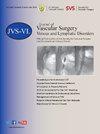下肢血栓形成后综合征患者血管内治疗后的四年预后。
IF 2.8
2区 医学
Q2 PERIPHERAL VASCULAR DISEASE
Journal of vascular surgery. Venous and lymphatic disorders
Pub Date : 2025-05-14
DOI:10.1016/j.jvsv.2025.102260
引用次数: 0
摘要
目的:本研究旨在评估血管内治疗下肢血栓后综合征(PTS)的安全性和有效性,并确定导致支架内再狭窄的危险因素。方法:选取2016年5月至2022年4月在我院接受血管内治疗的PTS患者。临床症状采用Villalta评分、CEAP(临床、病因、解剖和病理生理)分类和静脉临床严重程度评分(VCSS)进行系统评估。采用双工超声(DUS)评估原发性和继发性通畅率。采用单因素和多因素Cox回归模型分析与支架内再狭窄相关的危险因素。采用重复测量方差分析(ANOVA)比较治疗前后临床症状评分。结果:共纳入115例患者。中位随访时间为48个月(24-65个月)。3个月、6个月、1年、2年、3年、4年的原发性通畅率分别为92.2%±2.5%、88.7%±3.0%、81.7%±3.6%、73.9%±4.1%、66.6%±4.5%、65.3%±4.6%。38例患者出现支架再狭窄。术后1年,VCSS显著降低7.0[95%置信区间(CI): 6.0-8.0;结论:血管内治疗具有良好的长期通畅率,是治疗PTS安全有效的方法。C5-C6的CEAP分级已被确定为支架再狭窄的危险因素。本文章由计算机程序翻译,如有差异,请以英文原文为准。
Four-year outcomes following endovascular treatment in patients with post-thrombotic syndrome of the lower extremities
Objective
This study aimed to evaluate the safety and efficacy of endovascular treatment for post-thrombotic syndrome (PTS) in the lower extremities, and to identify risk factors contributing to in-stent restenosis.
Methods
Patients with PTS who underwent endovascular treatment at our institution from May 2016 to April 2022 were included in this study. Clinical symptoms were systematically assessed using the Villalta score, the Clinical, Etiological, Anatomical, and Pathophysiological (CEAP) classification, and the Venous Clinical Severity Score. Primary and secondary patency rates were assessed by duplex ultrasound examination. Risk factors associated with in-stent restenosis were analyzed using univariate and multivariate Cox regression models. A repeated measures analysis of variance was conducted to compare clinical symptom scores before and after treatment.
Results
A total of 115 patients were included in the study. The median follow-up duration was 48 months (range, 24-65 months). The primary patency rates at 3 months, 6 months, 1 year, 2 years, 3 years, and 4 years were 92.2% ± 2.5%, 88.7% ± 3.0%, 81.7% ± 3.6%, 73.9% ± 4.1%, 66.6% ± 4.5%, and 65.3% ± 4.6%, respectively. Stent restenosis was observed in 38 patients. At 1 year postoperatively, the Venous Clinical Severity Score exhibited a significant reduction of 7.0 (95% confidence interval [CI]. 6.0-8.0; P < .001) relative to preoperative levels. The Villalta score demonstrated a significant decrease of 11.4 (95% CI, 9.4-13.5; P < .001) compared with preoperative levels. Cox regression analysis indicated that a CEAP classification of C5 or C6 (hazard ratio, 2.24; 95% CI, 1.18-4.25; P = .014) was associated with stent restenosis.
Conclusions
Endovascular treatment, with favorable long-term patency rates, is a safe and effective approach for managing PTS. CEAP classification of C5 or C6 has been identified as a risk factor for stent restenosis.
求助全文
通过发布文献求助,成功后即可免费获取论文全文。
去求助
来源期刊

Journal of vascular surgery. Venous and lymphatic disorders
SURGERYPERIPHERAL VASCULAR DISEASE&n-PERIPHERAL VASCULAR DISEASE
CiteScore
6.30
自引率
18.80%
发文量
328
审稿时长
71 days
期刊介绍:
Journal of Vascular Surgery: Venous and Lymphatic Disorders is one of a series of specialist journals launched by the Journal of Vascular Surgery. It aims to be the premier international Journal of medical, endovascular and surgical management of venous and lymphatic disorders. It publishes high quality clinical, research, case reports, techniques, and practice manuscripts related to all aspects of venous and lymphatic disorders, including malformations and wound care, with an emphasis on the practicing clinician. The journal seeks to provide novel and timely information to vascular surgeons, interventionalists, phlebologists, wound care specialists, and allied health professionals who treat patients presenting with vascular and lymphatic disorders. As the official publication of The Society for Vascular Surgery and the American Venous Forum, the Journal will publish, after peer review, selected papers presented at the annual meeting of these organizations and affiliated vascular societies, as well as original articles from members and non-members.
 求助内容:
求助内容: 应助结果提醒方式:
应助结果提醒方式:


